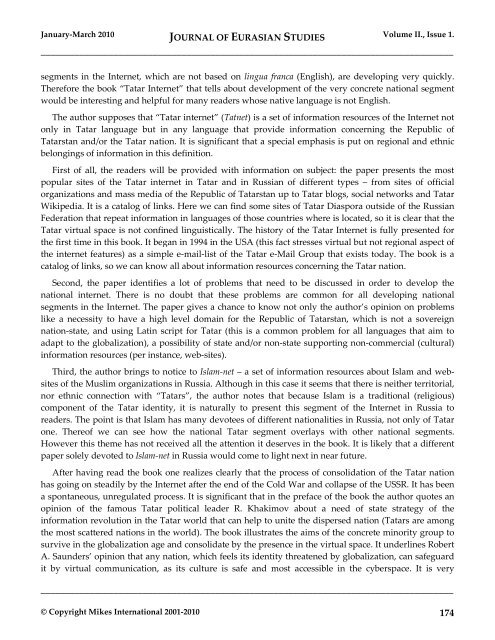EurasianStudies_0110..
EurasianStudies_0110..
EurasianStudies_0110..
You also want an ePaper? Increase the reach of your titles
YUMPU automatically turns print PDFs into web optimized ePapers that Google loves.
January-March 2010 JOURNAL OF EURASIAN STUDIES Volume II., Issue 1.<br />
_____________________________________________________________________________________<br />
segments in the Internet, which are not based on lingua franca (English), are developing very quickly.<br />
Therefore the book “Tatar Internet” that tells about development of the very concrete national segment<br />
would be interesting and helpful for many readers whose native language is not English.<br />
The author supposes that “Tatar internet” (Tatnet) is a set of information resources of the Internet not<br />
only in Tatar language but in any language that provide information concerning the Republic of<br />
Tatarstan and/or the Tatar nation. It is significant that a special emphasis is put on regional and ethnic<br />
belongings of information in this definition.<br />
First of all, the readers will be provided with information on subject: the paper presents the most<br />
popular sites of the Tatar internet in Tatar and in Russian of different types – from sites of official<br />
organizations and mass media of the Republic of Tatarstan up to Tatar blogs, social networks and Tatar<br />
Wikipedia. It is a catalog of links. Here we can find some sites of Tatar Diaspora outside of the Russian<br />
Federation that repeat information in languages of those countries where is located, so it is clear that the<br />
Tatar virtual space is not confined linguistically. The history of the Tatar Internet is fully presented for<br />
the first time in this book. It began in 1994 in the USA (this fact stresses virtual but not regional aspect of<br />
the internet features) as a simple e-mail-list of the Tatar e-Mail Group that exists today. The book is a<br />
catalog of links, so we can know all about information resources concerning the Tatar nation.<br />
Second, the paper identifies a lot of problems that need to be discussed in order to develop the<br />
national internet. There is no doubt that these problems are common for all developing national<br />
segments in the Internet. The paper gives a chance to know not only the author’s opinion on problems<br />
like a necessity to have a high level domain for the Republic of Tatarstan, which is not a sovereign<br />
nation-state, and using Latin script for Tatar (this is a common problem for all languages that aim to<br />
adapt to the globalization), a possibility of state and/or non-state supporting non-commercial (cultural)<br />
information resources (per instance, web-sites).<br />
Third, the author brings to notice to Islam-net – a set of information resources about Islam and websites<br />
of the Muslim organizations in Russia. Although in this case it seems that there is neither territorial,<br />
nor ethnic connection with “Tatars”, the author notes that because Islam is a traditional (religious)<br />
component of the Tatar identity, it is naturally to present this segment of the Internet in Russia to<br />
readers. The point is that Islam has many devotees of different nationalities in Russia, not only of Tatar<br />
one. Thereof we can see how the national Tatar segment overlays with other national segments.<br />
However this theme has not received all the attention it deserves in the book. It is likely that a different<br />
paper solely devoted to Islam-net in Russia would come to light next in near future.<br />
After having read the book one realizes clearly that the process of consolidation of the Tatar nation<br />
has going on steadily by the Internet after the end of the Cold War and collapse of the USSR. It has been<br />
a spontaneous, unregulated process. It is significant that in the preface of the book the author quotes an<br />
opinion of the famous Tatar political leader R. Khakimov about a need of state strategy of the<br />
information revolution in the Tatar world that can help to unite the dispersed nation (Tatars are among<br />
the most scattered nations in the world). The book illustrates the aims of the concrete minority group to<br />
survive in the globalization age and consolidate by the presence in the virtual space. It underlines Robert<br />
A. Saunders’ opinion that any nation, which feels its identity threatened by globalization, can safeguard<br />
it by virtual communication, as its culture is safe and most accessible in the cyberspace. It is very<br />
_____________________________________________________________________________________<br />
© Copyright Mikes International 2001-2010 174

















